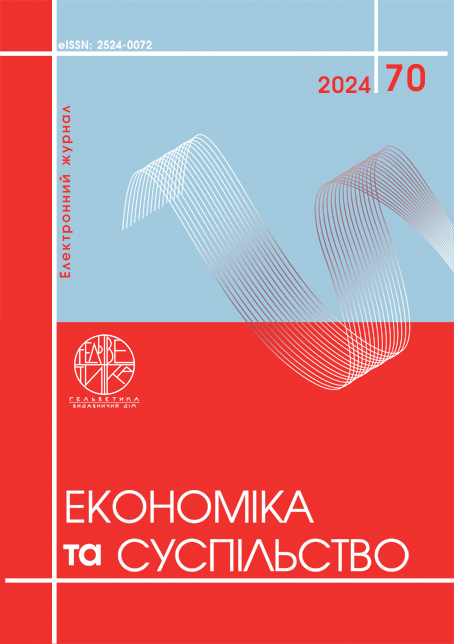CIRCULAR BUSINESS MODELS: IMPLEMENTATION BARRIERS AND CONSUMER BEHAVIOR
Abstract
The relevance of the study lies in the need for innovative approaches to business models that can contribute to the sustainable development of the country, particularly in the context of rebuilding infrastructure and minimizing the ecological damage caused by the war. A review of existing literature reveals that while significant strides have been made globally in implementing CBMs, there are several barriers to their widespread adoption in Ukraine. These barriers are technical, economic, social, and regulatory in nature. Technically, there is a lack of infrastructure for efficient waste collection and recycling, particularly for electronic waste, which is critical for advancing circular processes. Economically, the initial investment required for adopting circular practices is often seen as prohibitive, especially for small and medium-sized enterprises. Socially, the general public’s awareness and willingness to engage with sustainable consumption habits remain low. Additionally, regulatory frameworks supporting circular practices are insufficient, which hinders businesses from fully integrating circular economy principles. The paper emphasizes the importance of consumer behavior in the successful implementation of CBMs. It discusses how public awareness campaigns and educational initiatives can play a crucial role in shaping consumer attitudes towards sustainable consumption. Furthermore, the paper highlights the necessity of creating financial incentives, such as subsidies and tax breaks, to make circular products more affordable for the general population. It also discusses the role of eco-branding in promoting circular products by enhancing consumer trust and loyalty, as well as fostering a culture of sustainability. In conclusion, the research underscores the importance of strategic investments in infrastructure, technology, and education to create an enabling environment for CBMs in Ukraine. It also highlights the need for a comprehensive regulatory framework and the active participation of both the public and private sectors to drive the transition to a circular economy. By addressing these barriers and leveraging the potential of consumer behavior change, Ukraine can achieve sustainable economic growth, reduce environmental impact, and foster innovation in its post-war recovery efforts.
References
Bocken N.M.P., Bakker C., and I. De Pauw. Product design and business model strategies for a circular economy. Journal of Industrial and Production Engineering. 2016. vol. 1015. 20.
Kirchherr J., Reike D., Hekkert M. Conceptualizing the circular economy: An analysis of 114 definitions. Resources, Conservation & Recycling. 2017. No. 127. P. 221-232.
Geissdoerfer M. et al. The circular economy: A new sustainability paradigm? Journal of Cleaner Production. 2017. Vol. 143. Р. 757-768.
Rizos V. et al. Implementation of circular economy business models by small and medium-sized enterprises (SMEs): barriers and enablers. Sustainability. 2016. 8(11). Р. 1212-1230.
Stahel W. R. The circular economy. Nature. 2016. 531(7595). Р. 435-438.
Бурлуцька С. В., Дідашко Ю. І. Циркулярна економіка в контексті сталого розвитку. Наукові праці Національного університету харчових технологій. 2021. Т. 27, № 6. С. 55-64.
Подра О. П., Горошко Ю. В. Циркулярні моделі управління розвитком бізнесу: проблеми та перспективи в Україні. Бізнес Інформ. 2022. № 11. С. 231-236.
Руда М. В., Мирка Я. В. Циркулярні бізнес-моделі в Україні. Менеджмент та підприємництво в Україні: етапи становлення та проблеми розвитку. 2020. Том 2, № 1. С. 107-121.
Тесленок І. М., Златьєв К. Ю. Циркулярна економіка: концептуальні засади. Ефективна економіка. 2024. № 6. URL: http://nbuv.gov.ua/UJRN/efek_2024_6_54 (дата звернення: 21.11.2024).
Трушкіна Н. В. Циркулярна економіка: становлення концепції, еволюція розвитку, бар’єри, проблеми і перспективи. Вісник економічної науки України. 2021. № 1. С. 9-20.
Черевко Г., Коцай В. Циркулярна економіка, соціальна відповідальність та конкурентоспроможність підприємства. Аграрна економіка. 2023. Т. 16, № 3-4. С. 15-26.
Швець А. І. Циркулярна економіка як нова модель розвитку економіки України в процесі євроінтеграції. Економічний вісник Дніпровської політехніки. 2022. № 1. С. 43-49.
Kirchherr J., et al. Barriers to the circular economy: evidence from the European Union (EU). Ecological Economics. 2018. Vol. 150. P. 264-272.
Maitre-Ekern E., Dalhammar C. Towards a hierarchy of consumption behaviour in the circular economy. Maastricht Journal of European and Comparative Law. 2019. 26(3). P. 394-420.
Michaud C., Lerena D. Green consumer behaviour: an experimental analysis of willingness to pay for remanufactured products. Business Strategy and the Environment. 2011. 20(6). P. 408-420.
Mugge R. Product design and consumer behaviour in a circular economy. Sustainability. 2018. 10(10). 3704.
Parajuly K., Fitzpatrick C., Muldoon O., Kuehr R. Behavioral change for the circular economy: a review with focus on electronic waste management in the EU. Resources, Conservation and Recycling. 2020. X. 6. 00035.
Corsini F., Gusmerotti N.M., Frey M. Consumer’s Circular Behaviors in Relation to the Purchase, Extension of Life, and End of Life Management of Electrical and Electronic Products: A Review. Sustainability. 2020. 12(24). 10443.
Cakmakci Y., Hurma H., Cakmakci C. Determination of Consumer Perceptions of Eco-Friendly Food Products Using Unsupervised Machine Learning. Tekirdağ Ziraat Fakültesi Dergisi. 2024. 21. P. 634-647.
Bocken, N.M.P., Bakker, C., and I. De Pauw. (2016). Product design and business model strategies for a circular economy. Journal of Industrial and Production Engineering, 1015, 20.
Kirchherr, J., Reike, D., Hekkert, M. (2017). Conceptualizing the circular economy: An analysis of 114 definitions. Resources, Conservation & Recycling, 127, 221-232.
Geissdoerfer, M. et al. (2017). The circular economy: A new sustainability paradigm? Journal of Cleaner Production, 143, 757-768.
Rizos, V. et al. (2016). Implementation of circular economy business models by small and medium-sized enterprises (SMEs): barriers and enablers. Sustainability, 8(11), 1212-1230.
Stahel, W. R. (2016). The circular economy. Nature, 531(7595), 435-438.
Burlutska S. V., Didashko Yu. I. (2021). Tsyrkulyarna ekonomika v konteksti staloho rozvytku [Circular economy in the context of sustainable development]. Naukovi pratsi Natsionalʹnoho universytetu kharchovykh tekhnolohiy - Scientific works of the National University of Food Technologies, vol. 27(6), pp. 55-64.
Podra O. P., Goroshko Yu.V. (2022). Tsyrkulyarni modeli upravlinnya rozvytkom biznesu: problemy ta perspektyvy v Ukrayini [Circular business development management models: problems and prospects in Ukraine]. Biznes Inform - Business Inform, vol. 11, pp. 231-236.
Ruda M. V., Myrka Y.V. (2020). Tsyrkulyarni biznes-modeli v Ukrayini [Circular business models in Ukraine]. Menedzhment ta pidpryyemnytstvo v Ukrayini: etapy stanovlennya ta problemy rozvytku - Management and entrepreneurship in Ukraine: stages of formation and development problems, vol. 2 (1), pp. 107-121.
Teslenok I. M., Zlatiev K. Yu. (2024). Tsyrkulyarna ekonomika: kontseptualʹni zasady [Circular Economy: Conceptual Framework]. Efektyvna ekonomika - Efficient economy, vol. 6. Available at: http://nbuv.gov.ua/UJRN/efek_2024_6_54 (accessed November 21, 2024).
Trushkina N. V. (2021). Tsyrkulyarna ekonomika: stanovlennya kontseptsiyi, evolyutsiya rozvytku, barʺyery, problemy i perspektyvy [Circular economy: the emergence of the concept, the evolution of development, barriers, problems and prospects]. Visnyk ekonomichnoyi nauky Ukrayiny - Bulletin of Economic Science of Ukraine, vol. 1, pp. 9-20.
Cherevko H., Kotsai V. (2023). Tsyrkulyarna ekonomika, sotsialʹna vidpovidalʹnistʹ ta konkurentospromozhnistʹ pidpryyemstva [Circular economy, social responsibility and enterprise competitiveness]. Ahrarna ekonomika - Agrarian economy, vol. 16(3-4), pp. 15-26.
Shvets A. I. (2022). Tsyrkulyarna ekonomika yak nova modelʹ rozvytku ekonomiky Ukrayiny v protsesi yevrointehratsiyi [Circular economy as a new model for the development of Ukraine's economy in the process of European integration]. Ekonomichnyy visnyk Dniprovsʹkoyi politekhniky - Economic Bulletin of the Dnipro Polytechnic, vol. 1, pp. 43-49.
Kirchherr, J., et al. (2018). Barriers to the circular economy: evidence from the European Union (EU). Ecological Economics, 150, 264-272.
Maitre-Ekern, E., Dalhammar, C. (2019). Towards a hierarchy of consumption behaviour in the circular economy. Maastricht Journal of European and Comparative Law, 26(3), 394-420.
Michaud, C., Lerena, D. (2011). Green consumer behaviour: an experimental analysis of willingness to pay for remanufactured products. Business Strategy and the Environment, 20(6), 408-420.
Mugge, R. (2018). Product design and consumer behaviour in a circular economy. Sustainability, 10(10), 3704.
Parajuly, K., Fitzpatrick, C., Muldoon, O., Kuehr, R. (2020). Behavioral change for the circular economy: a review with focus on electronic waste management in the EU. Resources, Conservation and Recycling, X. 6, 00035.
Corsini, F., Gusmerotti, N.M., Frey, M. (2020). Consumer’s Circular Behaviors in Relation to the Purchase, Extension of Life, and End of Life Management of Electrical and Electronic Products: A Review. Sustainability, 12(24), 10443.
Cakmakci, Y., Hurma, H., Cakmakci, C. (2024). Determination of Consumer Perceptions of Eco-Friendly Food Products Using Unsupervised Machine Learning. Tekirdağ Ziraat Fakültesi Dergisi, 21, 634-647.

This work is licensed under a Creative Commons Attribution 4.0 International License.


